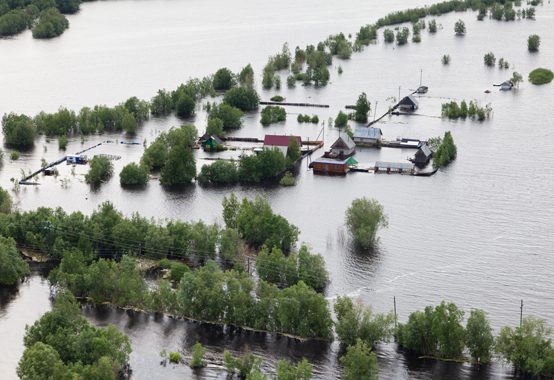Subsidizing Disaster

Sometimes it seems like everything is underwater. In Galveston, Texas, sea levels have risen by more than a foot since 1983. So-called “superstorms” like Hurricanes Sandy and Katrina have caused hundreds of billions in damage and lost economic output.
While the media are quick to pin the blame for these events on climate change—and some experts do believe, for example, that higher temperatures are providing “fuel” for hurricanes in the North Atlantic—both the Intergovernmental Panel on Climate Change and the National Oceanic and Atmospheric Administration have been reluctant to endorse such claims. But if that sounds reassuring, it shouldn’t.
Climate change is expected to increase storm intensity over the long term, and sea-level rise will leave coastal areas more vulnerable even to ordinary storms. And the IPCC did find an increase in damage from storms—concluding that “Economic growth, including greater concentrations of people and wealth in periled areas and rising insurance penetration, is the most important driver of increasing losses.”
In other words, storms are doing more damage not because they are more powerful but because more people are living in storm-prone areas. Fortunately, there’s something policymakers can do to reduce the damage: they can stop subsidizing population growth in high-risk areas.
About one-third of Americans—more than 100 million people—now live in low-lying coastal regions. Analysis by the Risky Business Project forecasts that between $48.2 billion and $68.7 billion worth of existing coastal property in the Southeast alone will be below sea level by 2050. Parts of Louisiana are expected to be at least 4.3 feet below sea level by the end of the century.
It may seem odd for people to be moving into these vulnerable areas. But one major explanation for this trend is simple: government is paying for it.
The National Flood Insurance Program, for example, offers policies to people in flood-prone areas. The NFIP was created in 1968 to address a gap in the private market—insurers weren’t confident that they could accurately assess the risks of flooding and were concerned about handling many claims at once when disaster struck. But even today, with much better modeling tools and sophisticated global markets that can spread risks far and wide, the NFIP still holds 5 million policies. This is because the NFIP charges rates so far below the levels that actuaries would recommend—in some areas, only 45 percent of the full level of risk—that private companies cannot compete.
State governments have also gotten in on the game. Every Gulf Coast state operates some form of state-backed insurance program for wind; Florida and Louisiana have programs to insure against other risks as well. In Texas, for example, residents of coastal counties can obtain wind coverage from the Texas Windstorm Insurance Association (TWIA), a state-created nonprofit. TWIA is meant to be an insurance provider of last resort, but its rates are substantially below what would be actuarially sound and do not vary geographically in the same ways that private insurance rates do. Since 2000, the number of TWIA policies has more than quintupled, from 50,000 to around 275,000.
People should be free to live where they want, provided they are willing to bear the risks of doing so. But masking the extent of risk through artificially low insurance rates is almost literally a recipe for disaster.
It’s also unsustainable. When insurance programs charge rates below what’s needed to meet expected damages, they naturally find themselves unable to pay out claims. The NFIP, which is supposed to be self-funding, is more than $20 billion in debt to federal taxpayers. After Hurricane Ike hit the Texas coast, TWIA’s financial situation grew so precarious that the organization briefly considered bankruptcy. In Florida, potential liabilities could amount to $2.7 trillion, so large the state itself might not be able to pay for it.
Part of the solution here is simple: the government should stop making things worse. Rates for programs like the NFIP and TWIA should be raised at least to market levels. Ideally, they would be a bit higher still, to ensure that people use those programs only when private insurance truly isn’t available.
But attempts to reform government disaster insurance have had mixed results. The biggest attempt has been the 2012 Biggert-Waters Flood Insurance Act, which, as enacted, would have phased out many of the NFIP’s subsidized rates. When the first rate increases hit, however, homeowners in affected areas responded with anger. The resulting political backlash led Congress to make a quick about-face, and in 2013 many of the reforms were delayed or suspended. Rate increases were slowed or canceled altogether, and the NFIP’s fiscal solvency was instead propped up by adding surcharges to policies across the board, including many that were near the cost of risk already. The result was to shift costs from riskier properties to those less at risk. While the new legislation temporarily patched up NFIP’s fiscal situation, it did not deal with the underlying problem that the program encourages development in flood-prone areas.
 The situation with TWIA has been a bit better. The organization’s financial situation has improved over the last few years owing to a combination of light storm activity and small but steady annual rate increases. TWIA has also started several voluntary “depopulation” programs that match current TWIA policyholders with private insurers willing to take over their policies. Yet TWIA remains one bad year away from fiscal distress, and state law empowers it to meet some shortfalls through mandatory contributions from private insurers operating in the state.
The situation with TWIA has been a bit better. The organization’s financial situation has improved over the last few years owing to a combination of light storm activity and small but steady annual rate increases. TWIA has also started several voluntary “depopulation” programs that match current TWIA policyholders with private insurers willing to take over their policies. Yet TWIA remains one bad year away from fiscal distress, and state law empowers it to meet some shortfalls through mandatory contributions from private insurers operating in the state.
More promising has been the experience in Florida. Florida’s state-run Citizens Property Insurance Corp.—once the largest property insurer in the state and among the largest in the country—has shed 60 percent of its exposure and over a million policies thanks to an aggressive depopulation program. Ironically, the very direness of Florida’s situation may have made serious reforms more viable.
If financial considerations alone are not enough reason to reform government disaster insurance, the climate-change factor should add extra urgency. Government policies that encourage people to live in vulnerable areas aren’t just economically perverse, they are downright immoral.
Josiah Neeley is Texas director for the R Street Institute.